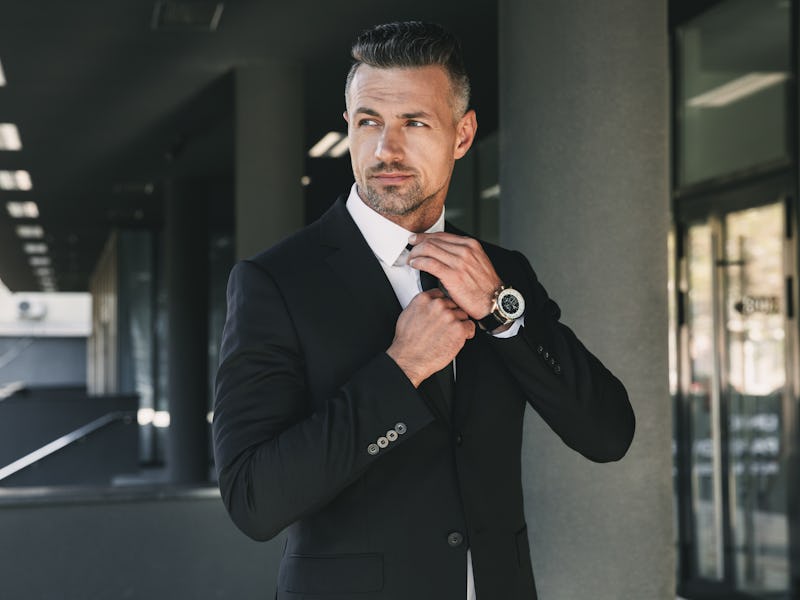The anatomy of a "bad boy," according to science
The hype behind the archetype.

You know the type: The guy with broad shoulders, a fictionally chiseled jawline, and a safely dangerous edge. He walks into a room elusive and leaves a lingering scent as he passes by — perhaps that's his literal air of confidence. He might be your best friend or a colleague that you can guarantee has a date or some otherwise exciting plan after happy hour. They say everyone loves a "bad boy," but why?
We have some answers thanks to our expert, Sarah Melancon, Ph.D. As a sociologist and clinical sexologist, her research and expertise explore the intersection of trauma, the autonomic nervous system, sexuality, birth, and intimate relationships. Here she shares how facial features, hormones, and the perception of masculine energy play a role in attraction to this archetype.
We only include products that have been independently selected by Inverse's editorial team. However, we may receive a portion of sales if you purchase a product through a link in this article.
It Starts With Bone Structure
Recently, Carolina Herrera launched its new Bad Boy cologne (more on scent in a minute) with Ed Skrein — who starred as the villain in Deadpool — as the face, and science might be why. "Some researchers think masculine facial features, such as a more prominent brow or stronger jawline, might signal health and genetic quality and thus be perceived as more attractive," says Melancon. Heterosexual women may initially prefer men with this type of bone structure; however, the effect doesn't always last. "Interestingly, women may prefer men with more masculine facial features for shorter-term relationships and men with less-masculine features for longer-term relationships," Melancon explains.
She says evolutionary psychologists think this is because men with more masculine features, being perceived as more attractive, also tend to have a greater number of sexual opportunities, making them less likely to make a parental investment. As the theory goes, "by comparison, men with less-masculine facial features have fewer opportunities for other partners and will thus have greater levels of parental investment in raising children," says Melancon.
Sprinkle In A Little Rebellion
If stereotypical "bad boys" don't yield a return on romantic investments, why the attraction? "Many women may be attracted to 'bad boys' not because of their personal qualities but because of the emotions they elicit and what those represent," says Melancon. "For instance, some adult women who still hold onto the need to be a 'good girl' may be attracted to the freedom and rebelliousness of a 'bad boy.'"
Add A Dose of Hormones
Jawlines and perceived rule breaking aren't the only components that play a part in the appeal. The human body has a hormone in the game: pheromones. Science tells us that animals use pheromones to communicate, but can they affect human interaction, specifically in finding partners? Maybe.
"Pheromones likely play a role in humans as well, though it may be more subtle than among other mammals," says Melancon. You’ve likely heard the term pheromone, but what are they exactly? “Pheromones are scents composed of chemical secretions emitted from an individual's body that influence the hormones and/or behavior of another person," Melancon explains. These chemical secretions, she says, can potentially play a role in attracting a sexual partner. "For instance, studies will have women smell worn and unworn men's T-shirts, asking them to rate the attractiveness of the scent or desire for sex."
And A Spritz Of A Signature Fragrance
Similar but different to pheromones, our unique body odors may also be an influence on our perceived attractiveness to a potential partner. "Like your fingerprint, everyone has a unique chemical profile, creating a specific scent," says Melancon, who adds that there are also studies linking perfume and cologne scents to perceived attractiveness. However, she says more research is needed to make a definitive connection.
The jury may still be out on how fragrance influences who we find attractive. However, ancient cultures have a long history of using spices like vanilla, pepper, cloves, saffron, and ginger as aphrodisiacal influences, according to a report from UCLA's History & Special Collections division of the Louise M. Darling Biomedical Library. These spices are often and unsurprisingly used in fragrances. Cue the Bad Boy cologne again: The Eau de Toilette fragrance has notes of vanilla, and black and white pepper, all of which can be linked to sparking romantic and sexual emotions.
All this is to say, it doesn't take movie-villain status to be a "bad boy." Although "the archetypal 'bad boy' is independent, strong, and a rebel without a cause...a man who is bold, self-sufficient, and/or takes calculated risks can be very attractive without the dark, emotionally unavailable, or manipulative elements," says Melancon.
This article was originally published on